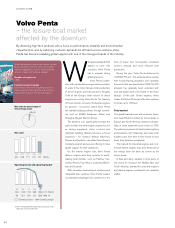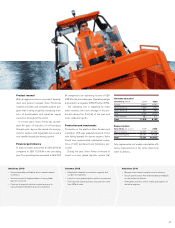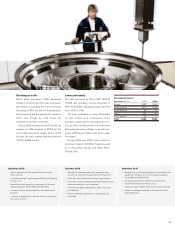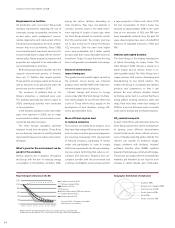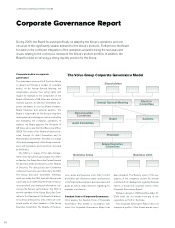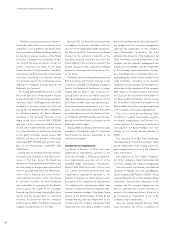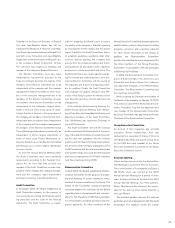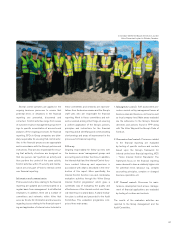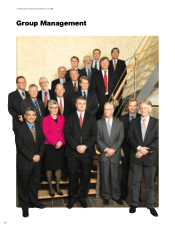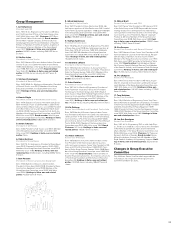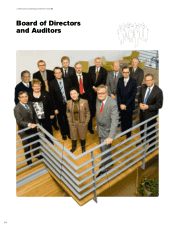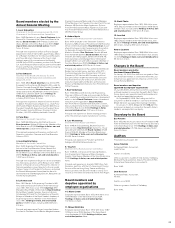Volvo 2009 Annual Report Download - page 59
Download and view the complete annual report
Please find page 59 of the 2009 Volvo annual report below. You can navigate through the pages in the report by either clicking on the pages listed below, or by using the keyword search tool below to find specific information within the annual report.
Key figures 2008 2009
Number of employees at year-end 101,380 90,208
Share of women, % 17 17
Share of women, Board Members, % 10 11
Share of women, Presidents and other senior executives, % 17 19
Absence due to illness in the Group's Swedish companies
Total absence due to illness of regular working hours, % 4.6 3.6
of which continuous sick leave for 60 days or more, % 39.1 35.8
Absence due to illness (as percentage of regular working hours) by gender
Men, % 4.4 3.5
Women, % 5.4 3.9
Absence due to illness (as percentage of regular working hours) by age
29 years or younger, % 4.6 2.7
30–49 years, % 4.6 3.6
50 years and older, % 4.8 3.7
Volvo Group Sustainable Report
will be available on www.volvogroup.com
in mid-April.
Volvo Group’s environmental
performance For information on the
Volvo Group’s environmental perform-
ance see the Eleven-year summary.
In this way, the Volvo Group has shown that it
is prepared for the fuels of the future, regard-
less of which alternative authorities choose to
invest in.
These activities resulted in the launch of the
BioDME project. The goal of the project is to
involve the entire production chain in the pro-
duction and distribution of DME from biomass
until it is used as fuel in vehicles. The project is
being nanced by the EU and the Swedish
Energy Agency. Volvo’s role in the project is to
serve as project coordinator and to build
vehicles for eld-testing.
Social responsibility
A key factor in realizing the Group’s vision is
the contribution of the employees and their
knowledge and expertise.
The Volvo Group aims to create a favorable
work environment that contributes to the
development of its competitiveness and attrac-
tiveness. As part of this aim, an increasing
number of its operations are being certied in
accordance with the international standard
for work-environment management systems,
OHSAS 18001.
It is important that the organization reflects
its customers and that it understands the con-
ditions prevailing in local markets, different
cultures and future employees requirements.
Diversity contributes
The Volvo Group as employer
The Group strives to be an attractive employer,
both for current and future employees. Every
employee is expected to take an active role in
the Group’s development, process of change
and future. The Group is working in a number
of different areas, such as tness programs,
skill development, work environment and lead-
ership support in an effort to be an attractive
employer.
Personnel reductions
Against the background of the overall low
demand, measures to decrease cost levels
within the Group continued. These measures
include a reduction in personnel and a review
of all expenses.
At the end of 2008 , the Group had 101,380
xed employees. In addition, there were 8,234
temporary employees and consultants. During
2009, the number of xed employees was
decreased to 90,208 and the number of tem-
porary employees and consultants to 6,074.
Before going so far as redundancy notices, a
host of other measures are taken, including
the utilization of exible time banks. The Volvo
Group is following national regulations in con-
junction with terminations of employment and
is cooperating closely with the unions.
During the second quarter agreements
were made with unions in Sweden for work
time and salary reduction in some plants and
ofces for the next three quarters. In total,
some 5,800 employees were covered by these
agreements. In addition, in countries where
this is possible, such as France, Belgium and
Germany, the Volvo Group uses various forms
of short-time work nanced by governments,
employees and the company, which signi-
cantly reduces the Group’s personnel costs.
The Volvo Group Attitude Survey is an
annual Groupwide survey. In the survey,
employees express their views on their work
and areas that need improvement. The results
of the survey are discussed in each team and
used to identity key improvement areas. The
proportion of satised employees has steadily
increased in recent years and continued to be
on a high level in 2009 in spite of the signi-
cant workforce-reduction – the proportion of
satised employees was 85%, compared with
86% in the preceding year.
Product quality and safety
Safety issues are a natural component of the
development of world-leading commercial trans-
port solutions. The Group strives to minimize the
risk and consequences of accidents and improve
driver safety and work environment. Human
errors or misjudgments are a decisive or strongly
contributory factor in most accidents, a fact that
reflects the importance of good visibility, driving
characteristics and brakes.
The Group is also a leader in designing vehi-
cles that protect the driver and passengers in
the event of a collision. Safety solutions include
rollover-tested cabs and bodies, frontal colli-
sion protection, deformation zones, seat belts,
deformable ttings and airbags.
The Group is also a leader in improving
safety for other road-users. As early as 1996,
the company introduced the Front Underrun
Protection System to prevent passenger cars
from becoming wedged beneath trucks in a
frontal collision. This protection system has
been tted as standard to Volvo’s trucks in the
EU since 2001, and in 2003 the protection
system became a legal requirement in EU
countries.
55



